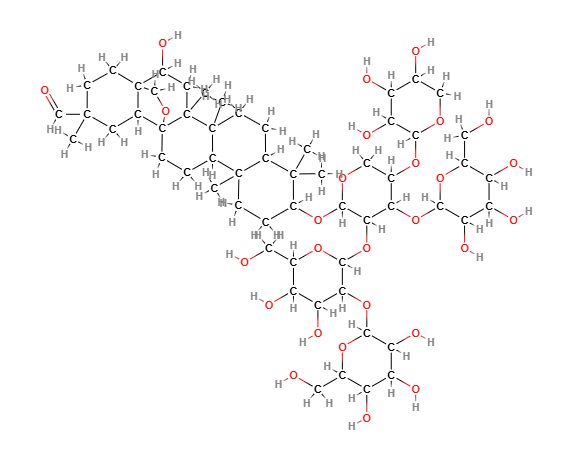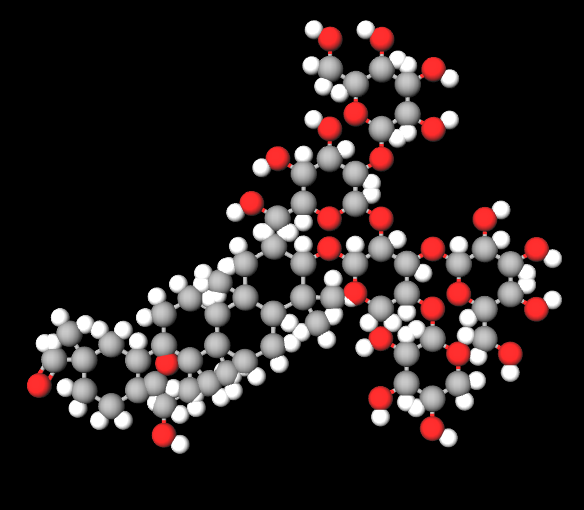| "Descrizione" by admin (19549 pt) | 2024-Jul-17 09:22 |
Saponins are natural compounds found in various plant species. They are glycosides with a distinctive foaming characteristic when shaken in aqueous solutions. Saponins are valued for their beneficial properties, making them popular in various applications, particularly in the fields of cosmetics, personal care, and medicine.
Chemical Composition and Structure
Saponins consist of a hydrophobic aglycone (sapogenin) attached to one or more hydrophilic sugar chains. The aglycone can be a triterpenoid or steroid, and the sugar moieties can include glucose, galactose, rhamnose, xylose, or other monosaccharides.
Physical Properties
Saponins typically appear as a white to off-white powder or as a clear to slightly yellowish liquid when in solution. They are soluble in water and ethanol, creating a characteristic foam when shaken in aqueous solutions.
Production Process
The production of saponins involves several steps:
Harvesting and Selection: Plants rich in saponins, such as soapwort, horse chestnut, and quinoa, are harvested and selected for quality.
Cleaning: The harvested plant materials are thoroughly cleaned to remove dirt and contaminants.
Extraction: The cleaned plant materials undergo an extraction process using solvents such as water, ethanol, or a combination to obtain the saponins.
Filtration: The extracted solution is filtered to remove any solid residues and impurities.
Purification: The saponins are purified through processes such as chromatography to isolate the desired components.
Drying: The purified saponins are dried to produce a fine powder.
Packaging: The final product is packaged under controlled conditions to ensure stability and purity.
Applications
- Cosmetics: In the cosmetics industry, saponins are valued for their cleansing, foaming, and emulsifying properties. They are commonly included in formulations of shampoos, soaps, and facial cleansers to enhance cleansing efficacy and foam production (1).
- Personal Care: Saponins are used in various personal care products such as body washes, toothpaste, and shaving creams for their natural surfactant properties.
- Medicine and Pharmaceuticals: Saponins have potential medicinal applications due to their anti-inflammatory, antimicrobial, and immune-stimulating properties. They are used in dietary supplements, vaccines, and herbal medicines (2).
Environmental and Safety Considerations
Environmental Impact: The production of saponins generally has a moderate environmental impact. Sustainable harvesting practices and the use of eco-friendly extraction methods can help minimize the overall impact.
Safety: Saponins are considered safe for topical use in the concentrations typically employed in consumer products. However, ingestion of high amounts can be toxic. It is essential to ensure that saponins are free from contaminants and comply with regulatory standards. Allergic reactions are rare but cannot be excluded.
Cosmetics - INCI Functions
- Cleansing agent. Ingredient that cleanses skin without exploiting the surface-active properties that produce a lowering of the surface tension of the stratum corneum.
- Surfactant - Emulsifying agent. Emulsions are thermodynamically unstable and are used to soothe or soften the skin and emulsify, so they need a specific, stabilising ingredient. This ingredient forms a film, lowers the surface tension and makes two immiscible liquids miscible. A very important factor affecting the stability of the emulsion is the amount of the emulsifying agent. Emulsifiers have the property of reducing the oil/water or water/oil interfacial tension, improving the stability of the emulsion and also directly influencing the stability, sensory properties and surface tension of sunscreens by modulating the filmometric performance.
- Surfactant - Cleansing agent. Cosmetic products used to cleanse the skin utilise the surface-active action that produces a lowering of the surface tension of the stratum corneum, facilitating the removal of dirt and impurities.
 |  |
Molecular Formula C55H86O24
Molecular Weight 1131.3 g/mol
CAS 8047-15-2 11006-75-0 72231-29-9
UNII
EC Number 232-462-6 229-880-6 600-985-2
Synonyms:
Sasanquasaponin
Saponin
Bibliografia__________________________________________________________________________
(1) Güçlü-Ustündağ O, Mazza G. Saponins: properties, applications and processing. Crit Rev Food Sci Nutr. 2007;47(3):231-58. doi: 10.1080/10408390600698197.
Abstract: Saponins are a diverse group of compounds widely distributed in the plant kingdom, which are characterized by their structure containing a triterpene or steroid aglycone and one or more sugar chains. Consumer demand for natural products coupled with their physicochemical (surfactant) properties and mounting evidence on their biological activity (such as anticancer and anticholesterol activity) has led to the emergence of saponins as commercially significant compounds with expanding applications in food, cosmetics, and pharmaceutical sectors. The realization of their full commercial potential requires development of new processes/processing strategies to address the processing challenges posed by their complex nature. This review provides an update on the sources, properties, and applications of saponins with special focus on their extraction and purification. Also reviewed is the recent literature on the effect of processing on saponin structure/properties and the extraction and purification of sapogenins.
(2) Moses T, Papadopoulou KK, Osbourn A. Metabolic and functional diversity of saponins, biosynthetic intermediates and semi-synthetic derivatives. Crit Rev Biochem Mol Biol. 2014 Nov-Dec;49(6):439-62. doi: 10.3109/10409238.2014.953628.
Abstract. Saponins are widely distributed plant natural products with vast structural and functional diversity. They are typically composed of a hydrophobic aglycone, which is extensively decorated with functional groups prior to the addition of hydrophilic sugar moieties, to result in surface-active amphipathic compounds. The saponins are broadly classified as triterpenoids, steroids or steroidal glycoalkaloids, based on the aglycone structure from which they are derived. The saponins and their biosynthetic intermediates display a variety of biological activities of interest to the pharmaceutical, cosmetic and food sectors. Although their relevance in industrial applications has long been recognized, their role in plants is underexplored. Recent research on modulating native pathway flux in saponin biosynthesis has demonstrated the roles of saponins and their biosynthetic intermediates in plant growth and development. Here, we review the literature on the effects of these molecules on plant physiology, which collectively implicate them in plant primary processes. The industrial uses and potential of saponins are discussed with respect to structure and activity, highlighting the undoubted value of these molecules as therapeutics.
Rao AV, Gurfinkel DM. The bioactivity of saponins: triterpenoid and steroidal glycosides. Drug Metabol Drug Interact. 2000;17(1-4):211-35. doi: 10.1515/dmdi.2000.17.1-4.211. PMID: 11201296.
Abstract. Triterpenoid and steroidal glycosides, referred to collectively as saponins, are bioactive compounds present naturally in many plants. They have considerable potential as pharmaceutical and/or nutraceutical agents in natural or synthetic form. Saponins, from a variety of sources, have been shown to have hypocholesterolemic, anti-coagulant, anticarcinogenic, hepatoprotective, hypoglycemic, immunomodulatory, neuroprotective, anti-inflammatory and anti-oxidant activity. This paper reviews saponin research of the last decade, focussing on developments in understanding their mechanism of action and structure-activity relationships. Virtually all of this work has used animal and in vitro models. To date there are very few human data.
Rao AV, Sung MK. Saponins as anticarcinogens. J Nutr. 1995 Mar;125(3 Suppl):717S-724S. doi: 10.1093/jn/125.3_Suppl.717S. PMID: 7884557
Abstract. Saponins, which are present in plants, have been suggested as possible anticarcinogens. They possess surface-active characteristics that are due to the amphiphilic nature of their chemical structure. The proposed mechanisms of anticarcinogenic properties of saponins include direct cytotoxicity, immune-modulatory effects, bile acid binding and normalization of carcinogen-induced cell proliferation. However, the anticarcinogenic effects of saponins from commonly consumed plant foods have not been studied. Soybeans are one of the most important sources of dietary saponins. They are the main protein supplier in many vegetarian diets. Our results showed that soybean saponins at the concentration of 150-600 ppm had a dose-dependent growth inhibitory effect on human carcinoma cells (HCT-15). Viability was also significantly reduced. Soybean saponins did not increase cell membrane permeability in a dose-dependent fashion, whereas gypsophilla saponin, a nondietary saponin, increased permeability with increasing concentrations. Electron microscopy indicated that soybean and gysophilla saponins alter cell morphology and interact with the cell membrane in different ways.
| Evaluate |

